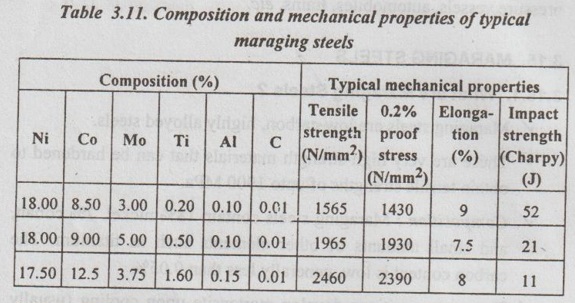Maraging steels are low-carbon, highly alloyed steels.
MARAGING STEELS
1. What are Maraging Steels?
✓ Maraging steels are low-carbon, highly alloyed steels.
✓ These are very high-strength materials that can be hardened to obtain tensile strengths of upto 1900 MPa.
✓ Composition: Maraging steels contain 18% nickel, 7% cobalt, TS and small amounts of other elements such as titanium. The carbon content is low, generally less than 0.05.
✓ These compositions develop martensite upon cooling (usually by air quenching) from the austenitizing temperature. The martensite formed in these steels, unlike the martensite of other todqm alloy steel, is ductile and tough. The ductility and toughness of this martensite result from its very low carbon content.
✓ In the martensitic condition, these steels can be cold worked rolls and can be hardened by precipitation at temperatures below the austenitizing temperature to achieve high tensile strength.
Note
1. Since nickel is a predominant constituent of maraging steels, therefore maraging steels are sometimes termed as special type high-nickel steel.
2. Since carbon does not play any part in developing the high strength and is only residual from the manufacturing process, therefore maraging steels are considered as high-strength ailoys rather than as steels. Because we know that steels normally depend for their properties on the presence of carbon.
2. Composition and Mechanical Properties of Typical Maraging Steels
Table 3.11 presents the composition of typical maraging steels and their mechanical properties.

3. Characteristics of Maraging Steels
The important properties of maraging steels are given below:
(i) Maraging steels have very high tensile strength and impact strength.
(ii) These steels combine considerable toughness with high ort wold strength and are far superior than conventional alloy constructional steels.
(iii) They are also very suitable for surface hardening by pay for nitriding.
(iv) They can be welded, if welding is followed by the full solution and ageing treatment.
4. Applications of Maraging Steels
Maraging steels find a wide variety of uses such as the flexible drive shafts for helicopters, barrels for rapid-firing guns, die-casting dies, and extrusion rams, space-vehicle cases, etc.
Note
In addition to the above discussed steels, there are some other important steels. They include:
1. Heat resisting steels:
✓ Steels which can resist the creep and oxidation at high temperatures and retain sufficient strength are called heat resisting steels.
✓ A typical composition of a heat resisting steel is given below: beniup 0.4% C, 10% Cr, 0.2% Si, 1.4% Mo, 36% Ni.
✓ Application: Such steels are used for exhaust valves of IC engines, conveyor chains and other furnace parts, racks for enamelling stoves, annealing-boxes, rotors for steam and gas turbines, and other fittings.
2. Hadfield's manganese steels:
✓ This is a high-alloy steel that contains 12-14% of Mn, and 1% of C. It is a non-magnetic.
✓ This type of steel is unique in that any attempt to deform, or abrade, the robnu material greatly increases the surface hardness.
✓ Application: Because of the exceptionally high resistance to abrasion, Hadfield's manganese steels are used for pneumatic drill bits, rock crusher jams, excavator bucket teeth, and railway points and switches.
3. Free-machining steels:
✓ These steels, also known as free cutting steels, machine readily and form small chips so as to reduce the rubbing against the cutting tool and associated friction and wear.
✓ They have higher sulphur (or lead) content than other carbon steels.
4. Magnet alloys:
✓ The temporary magnets are made out of a silicon- bearing steel, of very low carbon content.
✓ The permanent magnets are made from iron along with nickel, cobalt, and the rare earth metal gadolinium.
No comments:
Post a Comment